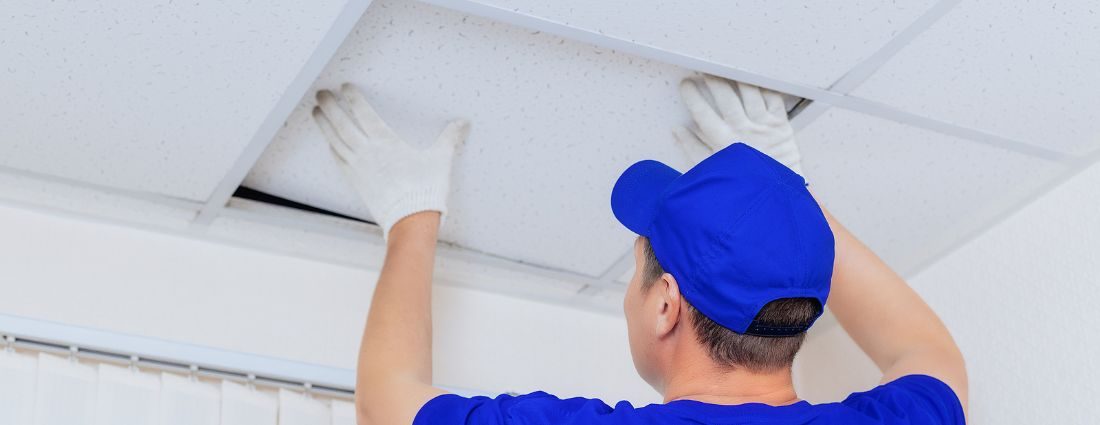You’ve probably heard of asbestos and even the dangerous health risks associated with this hazardous substance. Unfortunately, because it was widely used in building materials throughout the 20th century, you may still have some sticking around your home or office.
At Disaster Kleenup Specialists, we’ve put together 5 preliminary signs that your ceiling tiles could be affected.
- Color & Texture – Light, Textured, Or Soft Tiles
- Size – 2×2′ Or 2×4′ Acoustic, Drop & Suspended Tiles
- Date Of Manufacture – Mid 1980’s Or Earlier
- Manufactured By A Company That Used Asbestos
- Date Of Building Construction – Especially Pre-1980’s
1. Color & Texture Of Asbestos Tiles
Asbestos-containing materials can be very difficult to identify with the naked eye. Affected ceiling tiles are often light in color and mildly textured. Surface pinholes are one clue. If your ceiling material looks soft, powdery, or easy to crumble, chances are they contain asbestos.
2. Size Of Asbestos Ceiling Tiles
Acoustic, drop, and suspended ceilings are potentially at risk. Many manufacturers also produced asbestos ceiling tiles that were either 2 x 2-foot square or 2 x 4 foot rectangular, although they may have also manufactured other sizes.
3. Tile Manufacture Date & Ceiling Age
Your builder or a previous homeowner may have stored spare tiles in attic crawl spaces, basements, and other storage areas. If you have found any old replacements lying around, a professional can check the back for potential manufacturing information.
If your tiles or the ceiling itself predates the mid-1980s, you could be at risk.
4. Asbestos Tile Manufacturers
Here is a shortlist of some of the companies that manufactured ceiling tiles containing asbestos. Check any spare tiles you might have found in a storage location — but don’t try to peel any loose ones off to check.
- Flintkote Company
- Celotex
- Armstrong Corporation
- United States Gypsum
- National Gypsum
- Affa Tile Company
- Owens-Corning Fiberglass
5. Older Buildings Or Parts Of Buildings
If your home was built after the mid-1980s, chances are your ceiling is not a problem. However, asbestos-containing materials were widely used prior to 1980, and can’t always be identified via the visual checks listed above. Older homes are often suspect because asbestos use was so widespread.
Why Remove Asbestos?
It’s easy in hindsight to criticize companies for manufacturing cancer-causing building materials, but when asbestos was first introduced, its dangers were not known. The substance was inexpensive, heat and electricity resistant, so it seemed ideal to build safe, fire-resistant homes.
Unfortunately, it turns out that asbestos fibers can cause severe lung diseases and a deadly cancer called mesothelioma, which is why the U.S. started heavily regulating it during the 1970s. If you are in doubt about whether or not you have asbestos ceiling tiles, we can help get you the peace of mind you want.
Asbestos Ceiling Removal In Central CA
Changing out a pre-1980 ceiling in California is not a DIY job. If you live in the Monterey or Santa Cruz area and need to have your ceiling inspected or removed, Disaster Kleenup Specialists can help.
We are a licensed asbestos removal contractor who will ensure you stay legal and safe. Call us today for more information.

